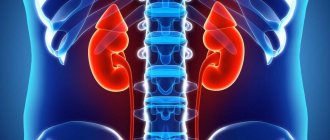Sign up for a consultation 8-921-389-56-85
specialist
Mediastinum (mediastinum) is a complex of organs located in the thoracic cavity between the left and right mediastinal pleura, the posterior surface of the sternum and the thoracic spine and necks of the ribs.
Most often, the mediastinum is divided into 3 sections (anterior - perivascular, middle - visceral, posterior - paravertebral). Tumors and cysts are neoplasms of various histogenesis, united into a common nosological group due to their location in the same anatomical area.
Pathomorphological forms are characterized by extreme diversity. The development of tumors and cysts among vital organs in a limited space leads to compression and displacement of mediastinal elements, creating a risk for the patient’s life.
Tumors can come from the organs themselves, ectopic ones, and the tissues between them. Cysts are a consequence of pathological processes and developmental defects with the formation of cavities.
Features of the problems of tumors and cysts are the morphological and anatomical and physiological characteristics of the mediastinum, the difficulties of morphological verification, and the uncertainty of treatment tactics for a number of diseases.
Prices for paid services
| Thoracic surgery | price, rub. |
| Drainage of the pleural cavity by endoscopic method Histological examination is paid additionally | 3 900 |
| Transthoracic biopsy Histological examination is paid additionally | 4 800 |
| Biopsy (needle) of the lung or mediastinal formations Histological examination is paid additionally | 5 500 |
| Open biopsy of the lung, mediastinal formations Histological examination is paid additionally | 21 230 |
| Endoprosthesis replacement of the trachea and bronchi with silicone prostheses | 41 360 |
| Drainage of moderate lung abscess with subsequent treatment | 5 500 |
| Sanitation of the pleural cavity with drugs for purulent diseases (1 procedure) | 4 800 |
| Diagnostic thoracoscopy | 11 770 |
| Video-assisted thoracoscopic splanchiectomy (one side) | 24 970 |
| Videomediastinoscopy | 22 000 |
| Video thoracoscopic lung biopsy Histological examination is paid additionally | 22 000 |
| Video thoracoscopic pleurectomy Histological examination is paid additionally | 26 400 |
| Video thoracoscopic pleurectomy with spraying of sclerosing agents Histological examination is paid additionally | 33 770 |
| Video-assisted thoracoscopic bullectomy using disposable staplers | 41 360 |
| Video thoracoscopic removal of peripheral lung formations Histological examination is paid additionally | 26 400 |
| Video thoracoscopic removal of mediastinal formations Histological examination is paid additionally | 32 230 |
| Microthoracotomy with video support and the use of reusable staplers | 22 000 |
| Pleurectomy Histological examination is paid additionally | 22 000 |
| Pleurectomy with lung decortication Histological examination is paid additionally | 32 230 |
| Regional resection of the lung Histological examination is paid additionally | 22 000 |
| Removal of a lung tumor (atypical resection) Histological examination is paid additionally | 26 400 |
| Removal of round peripheral lung formations Histological examination is paid additionally | 26 400 |
| Reduction of lung volume in patients with COPD, macrobullous or diffuse pulmonary emphysema | 65 890 |
| Decortication of the lung | 36 630 |
| Lobectomy category 1 | 41 030 |
| Lobectomy category 2 | 48 400 |
| Bilobectomy | 48 400 |
| Pneumonectomy Histological examination is paid additionally | 48 400 |
| Pneumonectomy with wedge resection of the tracheal bifurcation Histological examination is paid additionally | 58 630 |
| Pneumonectomy with circular resection of the tracheal bifurcation Histological examination is paid additionally | 58 630 |
| Circular resection of the trachea for neoplasms and cicatricial stenoses Histological examination is paid additionally | 77 660 |
| Chest resection | 26 400 |
| Surgery for mediastinal tumors Histological examination is paid additionally | 61 600 |
| Thoracoplasty | 44 000 |
| Embolization of bronchial arteries for pulmonary hemorrhage and/or hemoptysis | 22 000 |
| Therapeutic and diagnostic thoracoscopy, administration of drugs for the purpose of pleurodesis | 22 000 |
| Therapeutic and diagnostic video thoracoscopy | 23 430 |
| Therapeutic and diagnostic video thoracoscopy, administration of drugs for the purpose of pleurodesis | 26 400 |
| Drainage of the pleural cavity and pleurodesis | 17 600 |
| Videothoracoscopy, drainage of the pleural cavity and pleurodesis | 26 400 |
| Videothoracoscopy, pleural biopsy, drainage of the pleural cavity and pleurodesis Histological examination is paid additionally | 27 830 |
Mediastinal tumors
The clinical course of mediastinal tumors is divided into an asymptomatic period and a period of severe symptoms. The duration of the asymptomatic course is determined by the location and size of mediastinal tumors, their nature (malignant, benign), growth rate, and relationships with other organs. Asymptomatic tumors of the mediastinum usually become a finding during preventive fluorography.
General symptoms of mediastinal tumors include weakness, fever, arrhythmias, bradycardia and tachycardia, weight loss, arthralgia, and pleurisy. These manifestations are more characteristic of malignant tumors of the mediastinum.
Pain syndrome
The earliest manifestations of both benign and malignant tumors of the mediastinum are chest pain caused by compression or growth of the tumor into the nerve plexuses or nerve trunks. The pain is usually moderately intense and can radiate to the neck, shoulder girdle, and interscapular area.
Tumors of the mediastinum with left-sided localization can simulate pain resembling angina pectoris. When a tumor compresses or invades the mediastinum of the borderline sympathetic trunk, Horner's symptom often develops, including miosis, ptosis of the upper eyelid, enophthalmos, anhidrosis and hyperemia of the affected side of the face. If you have pain in the bones, you should think about the presence of metastases.
Compression syndrome
Compression of the venous trunks is primarily manifested by the so-called superior vena cava syndrome (SVVC), in which the outflow of venous blood from the head and upper half of the body is disrupted. SVC syndrome is characterized by heaviness and noise in the head, headache, chest pain, shortness of breath, cyanosis and swelling of the face and chest, swelling of the neck veins, and increased central venous pressure. In case of compression of the trachea and bronchi, cough, shortness of breath, and wheezing occur; recurrent laryngeal nerve - dysphonia; esophagus – dysphagia.
Specific manifestations
Some mediastinal tumors develop specific symptoms. Thus, with malignant lymphomas, night sweats and skin itching are observed. Mediastinal fibrosarcomas may be accompanied by a spontaneous decrease in blood glucose levels (hypoglycemia). Ganglioneuromas and neuroblastomas of the mediastinum can produce norepinephrine and epinephrine, which leads to attacks of arterial hypertension. Sometimes they secrete a vasointestinal polypeptide that causes diarrhea. With intrathoracic thyrotoxic goiter, symptoms of thyrotoxicosis develop. Myasthenia gravis is detected in 50% of patients with thymoma.
FEATURES DUE TO THE LOCALIZATION OF NEW FORMS
Tumors of the thymus gland. Of 85 observations, benign neoplasms were diagnosed in 44.7% of cases, and malignant ones in 55.3%. The clinical course of the disease was not always determined by the histological structure of the tumor and the nature of its growth. 70 (82.4%) patients underwent surgery; the rest received conservative treatment due to the prevalence of the tumor process.
Radical operations accounted for 59 (84.3%) cases; in the remaining patients, tumor removal was performed for palliative purposes; in 6 (8.6%) the operation was limited to exploratory thoracotomy. The adequate scope of surgical intervention for tumors of the thymus gland is thymomectomy - removal of the tumor and all tissue of the thymus gland with fatty tissue and lymph nodes of the anterior mediastinum. This volume of surgery was performed in 44 patients. In addition, 15 patients underwent extended-combined thymectomy due to tumor invasion into surrounding structures. Additional radiation and chemotherapy were carried out in 19.2% of cases (mainly for stages III-IV thymomas of types B2, B3 and C). Long-term results of surgical treatment. 84.8% of patients lived more than 3 years after radical surgical treatment, 82.6% lived more than 5 years, and 73.9% of patients lived more than 10 years. Long-term results were determined by the extent of the process (capsular invasion, pleural damage), and the histological type of tumor. Thus, thymomas of types A and B1 have the most favorable prognosis (90% of patients survive the 10-year period). For thymomas of types AB, B2 and B3, the 5-year survival rate was 64-68%; the prognosis for type C thymomas is significantly worse – 32%. In the absence of invasive growth, the histological form of thymoma does not affect the long-term results of surgical treatment. Thymomas with invasion within the capsule are clinically malignant and require postoperative radiation treatment.
Neurogenic tumors (89 cases) are divided into two histogenetic groups: neoplasms from nerve tissue cells (22; 24.7%) and from peripheral nerve sheaths (67; 75.3%). Benign tumors (schwannomas, neurofibromas, ganglioneuromas, paragangliomas) were detected in 69.7%, malignant tumors (Ewing sarcomas, neuroblastomas, ganglioneuroblastomas, etc.) – in 30.3% of patients. The solution to treatment problems was determined by the characteristic localization of neurogenic tumors and the characteristics of their spread.
86 (96.6%) patients underwent surgery (most of them radically). Radical operations are mainly performed for benign neurogenic tumors; for malignant neoplasms, radical surgical interventions amounted to 54.2%, palliative ones – 45.8%. A typical version of the operation, involving removal of a mediastinal tumor, was performed in 81.4% of cases, combined - in 18.6% of cases. In case of malignant tumors, this ratio was 62.5 and 37.5%, respectively (7 patients), and typical operations were performed in combination with genic mediastinal tumors. Postoperative radiation or chemotherapy is indicated when there is doubt about the radicalism of the operation or when a significant extent of the tumor is detected. The prescription of additional radiation or chemotherapy is justified by information about the pathomorphosis of tumors and observations of tumor regression. The relapse rate after radical surgery was 4.8%. Continued tumor growth after palliative operations was detected in 72.8% of cases already at the end of the first year of observation. In this regard, the expediency of repeated (and multiple) surgical interventions for relapses of neurogenic mediastinal tumors is obvious - only the surgical method can achieve prolongation of life and elimination of painful local manifestations of the disease. The overall 3-5 year survival rate after reoperation was 70.8-38.6%, compared with 25.0-12.5% among patients treated conservatively.
Mesenchymal tumors (52 observations) are represented by various histological forms: vascular tumors - 17 (32.6%); fat – 15 (28.8%); fibroblastic – 6 (11.5%), fibrohistiocytic – 2 (3.8%); osteochondral – 5 (9.6%); mesenchymomas – 2 (2.8%), as well as tumors from skeletal muscles – 1 (1.9%); synovial sarcoma – 1 (1.9%); sarcomas of unknown origin – 3 (5.8%). Benign tumors accounted for 42.3%, malignant tumors – 57.7% of cases. Treatment of patients with mesenchymal tumors, especially malignant ones, in conditions of low effectiveness of chemoradiotherapy, is only surgical. Surgical interventions are very complex, which is usually due to the prevalence of the process. Surgical treatment was performed in 40 patients, conservative treatment in 12. In terms of additional treatment, only 7 patients received pre- or postoperative chemoradiotherapy. After surgical treatment in a group of 19 patients with malignant neoplasms, relapses were detected in 13 cases (68.4%) - including 9 out of 11 palliative and 4 out of 8 radical operations (81.8 and 50%, respectively). For relapses, repeated operations were performed; one of the patients was operated on three times, the other four times. Overall and relapse-free 5-year survival rates for benign mesenchymal tumors tend to 100%. In case of malignant – 1-3-5-year life expectancy was 75; 62.5; 48.6% after radical operations and 63.6; 27.2; 18.1% – after palliative treatment.
Thus, even with a widespread tumor process and with locoregional relapses, active surgical tactics should be used. Repeated (and multiple) operations, including those for palliative purposes, make it possible to once again prolong life. The aggressive local growth inherent in mesenchymal tumors and the tendency to relapse justify the advisability of further searching for combination treatment options using neoadjuvant or adjuvant chemoradiotherapy. Each component of treatment should be used in full, constantly developing and improving.
Extragonadal germ cell tumors (EGT). 114 patients with extragonadal germ cell tumors of the mediastinum were observed: men – 97 (85.1%), women – 17 (14.9%) aged from 14 to 72 years, average age – 26 years. Seminoma was diagnosed in 17.5%, non-seminoma – in 82.5% of cases. Among patients with non-seminoma VGOs, embryonal cancer, yolk sac tumors, choriocarcinomas, teratomas of varying degrees of maturity, and dermoid cysts were identified. General principles of diagnosis and treatment. If the level of tumor markers (AFP, hCG, LDH) increases without signs of testicular damage, computed tomography of the chest, abdominal cavity and retroperitoneal space is necessary. With morphological confirmation of the diagnosis of a malignant intrathoracic germ cell tumor, 4-6 courses of chemotherapy (VER, BP, etc. regimens), radiation therapy (ROD = 2-3 Gy; SOD - up to 60-70 Gy) are indicated. The full effect of treatment of patients with extragonadal seminomas is recorded in 80%, with non-seminomas - in 23% of cases. The relapse rate was higher in the group of extragonadal nonseminoma tumors (6.7 and 29.4%; p<0.05). If the seminoma tumor persists after induction chemotherapy, dynamic observation is indicated. If there is residual nonseminoma tumor after completion of induction therapy, surgical treatment is recommended. An increase in markers is an indication for second-line chemotherapy. Identification of viable germ cells in the residual tumor determines postoperative chemotherapy.
Lymphomas (with damage to the mediastinal lymph nodes) without other manifestations of the disease were identified in 129 patients. Hodgkin's lymphomas were diagnosed in 82 patients, non-Hodgkin's lymphomas - in 47 patients. The morphological diagnosis was established using surgical diagnostic methods. The surgical stage ended at the diagnostic stage. Subsequently, the patients were treated in accordance with the variant of lymphoma and a set of prognostic signs according to the chemotherapy and radiation therapy programs used at the Russian Cancer Research Center during the analyzed historical stages.
*
Diagnostics
The following methods are used in the diagnosis of mediastinal tumors:
• Detailed blood test.
• Bone marrow puncture (collection of a small amount of cerebrospinal fluid using a thick needle) followed by a myelogram (study of the cellular composition of the resulting fluid).
• Reaction with tuberculin antigen (a laboratory method that allows you to determine whether tuberculosis has become one of the causes of the disease).
• Wasserman reaction (a laboratory method that allows you to determine whether syphilis is one of the causes of the disease),
• Laboratory determination of tumor markers (unique proteins that appear in the blood only if there is a certain type of tumor in the body).
• Chest X-ray and CT scan allow us to determine the location of the tumor and make assumptions about its origin and the stage at which the tumor process is located.
• CT of the mediastinal vessels allows you to clarify the stage of the disease, identify the presence of metastases and get an idea of the potential outcome of the disease.
• MRI is especially important in making a diagnosis if the tumor is vascular in nature, as it allows you to examine the entire area of the mediastinum and see the location of each organ and vessel in a three-dimensional perspective.
• PET-CT is perhaps the most complex method for diagnosing tumors, but it is also the most effective, as it allows you to see even the smallest tumor and metastases, consisting of only a few cells.
• Biopsy - removal of a small area of diseased tissue to determine the type of tumor, treatment options and prognosis for the patient.
• Videothoracoscopy – when the diagnosis cannot be established in any other way, doctors perform a small operation: they place a camera inside the patient’s chest under anesthesia. The image from the camera is displayed on the screen, and the surgeon sees exactly which organ is affected by the tumor.
Classification and varieties
Primary tumors initially arise in this area, secondary tumors arise as a result of metastasis of tumors located in other organs. They can develop from different types of tissues: epithelial, nervous, connective, muscle, lymphatic, etc. Based on their location, they are divided into localized in the upper, middle or lower, as well as the anterior or posterior mediastinum.
Most often in connection with the mediastinal cavity they talk about thymomas - the most common type of neoplasm of the thymus gland. Also common formations of this localization include neuromas. While in adults the bulk of such neoplasias are benign, mediastinal tumors in children are often malignant. To determine their development, the traditional 4 stages for oncology are used. Some lung lesions are also classified as mediastinal cancer.
Our expert in this field:
Ivanov Anton Alexandrovich
Medical director, oncologist-surgeon, candidate of medical sciences
Call the doctor
Call the doctor
How does the da Vinci surgical robot work?
The operation of the da Vinci surgical robot is fully controlled by an experienced surgeon through small incisions no larger than 2 cm in size. An endoscope video camera inserted through one of the incisions transmits to the doctor a detailed three-dimensional image of the organ. As a result, the doctor can carefully plan the operation. The surgeon controls the instruments, which have 7 degrees of freedom of movement, thanks to EndoWrist technology and controls their movements inside the patient’s body remotely using special joysticks. Performing an operation using the da Vinci robot requires a highly qualified surgeon and special skills.








